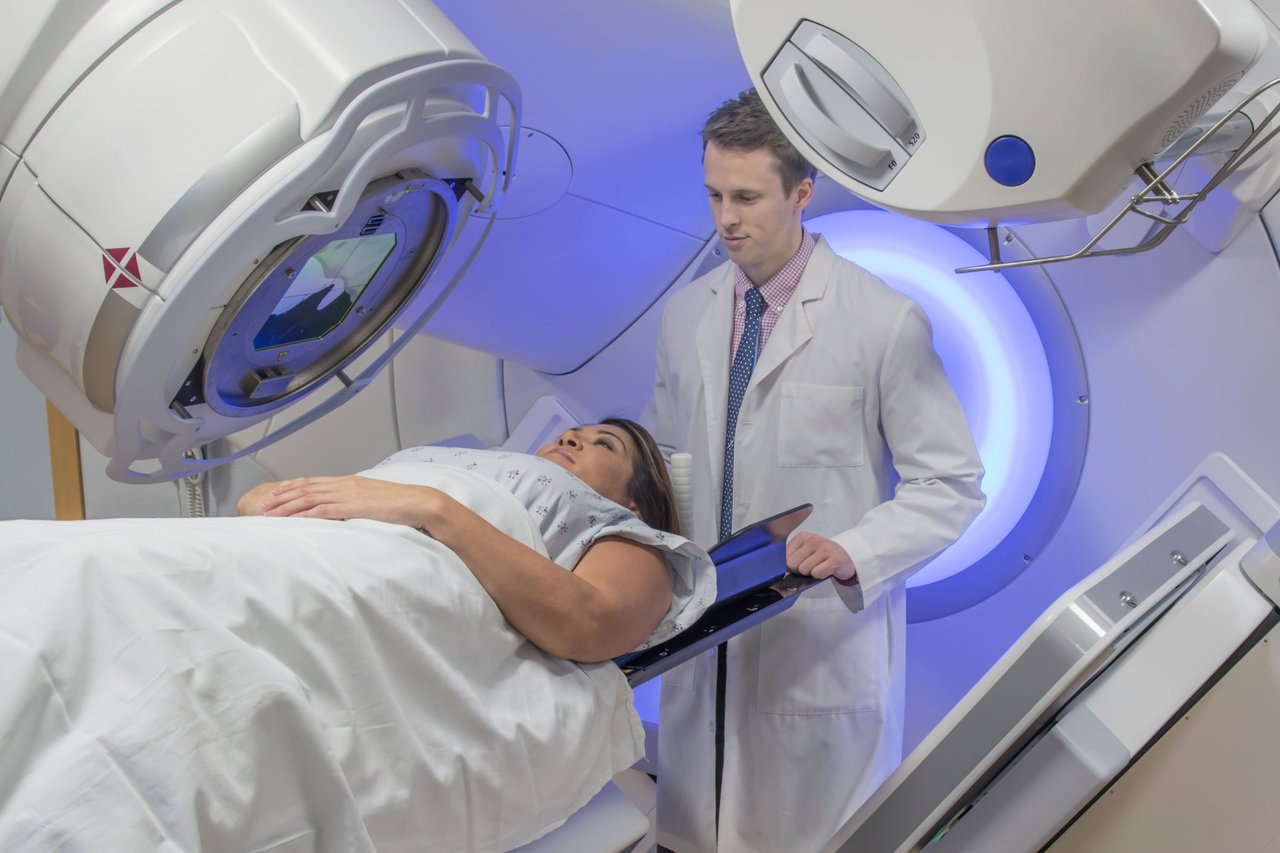
Many people diagnosed with breast cancer will receive radiation therapy as part of their treatment plan. Radiation therapy, called radiotherapy, uses high-energy particles to kill cancer cells.
It is most often used after breast-conserving surgery, also referred to as a lumpectomy. The radiation destroys any remaining cancer cells in the breast and surrounding lymph nodes. Most often, it’s administered externally. However, early-stage breast cancer can be treated with radiation that is inserted directly into the breast for short periods to deliver the radiation to the surgery site.
Let's take a deeper look at the types of radiation therapy for breast cancer and when they’re used.
Types of Radiation Therapy for Breast Cancer
Radiation therapy that is given externally is also called external beam radiation therapy. Radiation therapy delivered inside the breast is called high dose-rate (HDR) brachytherapy.
External Beam Radiation Therapy for Breast Cancer
External beam radiation therapy is the most common form of radiation used to treat breast cancer. It uses high-intensity radiation beams directed at a specific area of the body, such as the breast, to kill cancer cells. A large machine called a linear accelerator rotates around your body, delivering radiation beams from different angles directly to the targeted site. Your situation determines the areas of the body treated with radiation therapy:
- Patients who had breast-conserving surgery are likely to receive radiation to the entire breast to lower the likelihood of the cancer recurring.
- If breast cancer is found in the lymph nodes, radiation can be directed under the arms, above the collarbone, and/or beneath the breastbone.
- If radiation is needed after a complete breast removal surgery, called a mastectomy, the patient will receive radiation to the chest wall, mastectomy scar, and surgical drain sites. This is uncommon since the entire breast was removed during surgery. However, if the tumor was larger than 5 cm, cancer cells were found in many lymph nodes, or if the surgery margins were positive for cancer cells, radiotherapy may be recommended.
- If breast cancer has spread to other areas of the body, such as the liver or lung, radiation can be used to shrink the tumor, reducing the pain that it may be causing.
Keep in mind that radiation therapy after surgery doesn’t happen right away. It usually starts a few weeks to a few months afterward, allowing time for the body to heal first. If the treatment plan includes chemotherapy as well as radiation therapy, radiation treatments will usually begin after chemotherapy has finished.
Brachytherapy for Breast Cancer
Internal radiation therapy (more commonly called brachytherapy) is another way to deliver radiation therapy to the breast. Rather than aiming radiation from outside the body, brachytherapy involves putting a source of radiation into your body. This is usually done after a lumpectomy, but HDR brachytherapy can also be used for early-stage patients instead of surgery.
For breast cancer, the type of internal radiation used is called high dose-rate (HDR) brachytherapy. HDR brachytherapy allows breast cancer specialists to deliver precise radiation treatment directly to the breast cancer tumor. Thin applicator tubes, called catheters, are inserted directly into the affected area. Radioactive seeds or pellets are placed in the applicator tubes, left for a short period of time (about 10 to 20 minutes), and then removed. This process is repeated several times throughout your treatment period.
This form of radiation therapy reduces the risk of breast cancer recurrence, as does external beam radiation therapy. HDR brachytherapy also limits the radiation dose to surrounding normal tissue, including the chest wall and lungs.
Although brachytherapy can effectively deliver treatment to an exact area, it may not be appropriate for all breast cancer patients. Factors including tumor location and size may limit whether you can receive this treatment.
The American Brachytherapy Society recommends internal radiation therapy to women over the age of 45 following a lumpectomy if:
- The removed tumor is three centimeters or smaller in size, AND
- The cancer has not spread to the lymph nodes, AND
- No cancer cells were found in the rim of healthy tissue removed along with the cancer
The treatment period for internal radiation therapy is typically five days. Each day, a radioactive material is inserted into the catheter for a short time and then removed. That is repeated every day for five days.
The total number of days treatment is needed depends on various factors, including the specific type of breast cancer, other treatments planned, and the patient’s overall health condition. After the last session of HDR brachytherapy, the catheter and device are removed.
When is Radiation Therapy Given During a Breast Cancer Treatment Plan?
To determine the right plan for each patient, the medical oncologist, radiation oncologist, and surgeon will meet to discuss the specific patient’s needs and the timing they feel will work best for each treatment. There are several factors, such as the specific type of breast cancer, the type of breast cancer surgery that’s necessary, and the stage of the cancer, that influence if and how radiation therapy is included in the treatment plan. Your cancer care team may recommend one of the following:
- After a breast-conserving surgery (lumpectomy), to reduce the risk of breast cancer recurrence. This could be either external beam radiation therapy or HDR brachytherapy, depending on what the cancer care team determines is going to be most effective.
- After breast removal surgery (mastectomy), although this is rare. If the tumor was larger than 5 cm, cancer cells were found in many lymph nodes, or if the surgery margins were positive for cancer cells, radiotherapy may be recommended.
- Before breast cancer surgery, to reduce the size of the tumor. This may be given in combination with chemotherapy.
- Instead of surgery for patients whose breast cancer cannot be surgically removed.
- To manage side effects caused by the cancer spreading (metastasizing) to other parts of the body, such as the bones, spinal cord, or brain.
What to Expect When Receiving External Beam Radiation Therapy
Before starting treatment, images of the breast allow the oncologist to see the exact location and shape of the tumor(s). The radiation oncology team will use this information to determine where to direct the beams and the appropriate dose for each session. You will also receive small skin markings known as radiation tattoos. These marks help the radiation technician aim the radiation precisely where it’s needed each session. All this is done during a planning session when you won’t receive radiation therapy.
Radiation therapy is given five days a week for several weeks. Standard radiation therapy usually takes 6-8 weeks. Hypofractionated radiation therapy, which delivers a higher dose per session with no additional side effects, requires fewer visits and usually takes 4-5 weeks. The treatment will last no more than a few minutes each session and is painless. You may be slightly uncomfortable lying on the table under the linear accelerator for a few minutes. Try to wear comfortable clothing to each session.
Because of the frequency of your external beam radiation therapy visits, it’s a good idea to find a cancer treatment team close to your home or work so that you won’t have to spend too much time traveling to and from the cancer center for these short sessions.
Potential Radiation Therapy Side Effects for Breast Cancer Patients
While the treatment itself is painless, many patients experience skin changes over time in the treatment area. These changes vary among patients, ranging from mild, like a red and itchy sunburn, to more severe reactions, such as burning, soreness, peeling blisters, and darkening of the skin on the breast.
Telangiectasis, known as spider veins, may develop months or years after treatment. Usually painless, there can be a patch of tiny blood vessels that appear on the skin of the breast that received radiation therapy. For some, it may cause some itching or mild pain.
Other common side effects of external radiation therapy are:
- swelling in the breast
- changes in skin sensation
- mild to moderate fatigue
- armpit discomfort
These typically go away altogether or are at least less intense after the treatments are complete.
Breast Cancer Treatment, Including Radiation Therapy, is Available at New York Oncology Hematology
The New York Oncology Hematology cancer centers are ready to help patients with a breast cancer diagnosis. Our oncologists will talk you through every recommendation in your plan so you understand how each element works together to treat your specific type of breast cancer.
Request an appointment with one of our breast cancer specialists throughout the Capital District, including Albany, Troy, Amsterdam, Clifton Park, and Hudson, NY.


